Click on images to enlarge

infestation (Photo: Rob and Fiona Richardson)

mass amenity planting (Photo: Sheldon Navie)
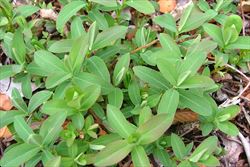
habit of young re-growth (Photo: Sheldon Navie)
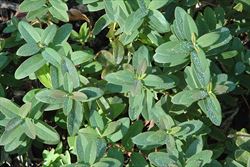
habit prior to flowering (Photo: Rob and Fiona Richardson)
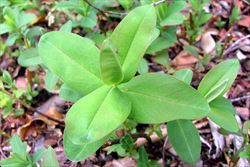
younger leaves (Photo: Sheldon Navie)
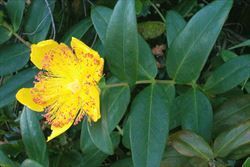
paired leaves and flower (Photo: Greg Jordan)

older leaves and immature fruit (Photo: Rob and Fiona Richardson)
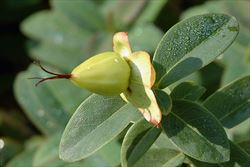
close-up of immature fruit (Photo: Rob and Fiona Richardson)
Scientific Name
Hypericum calycinum L.
Family
Clusiaceae (Queensland, New South Wales, the ACT, Victoria, Tasmania, Western Australia and the Northern Territory)Guttiferae (South Australia)
Common Names
Aaron's beard, creeping St. John's wort, goldflower, large flowered St John's wort, large-flowered St. John's wort, rose of Sharon, rose-of-Sharon, St. John's wort
Origin
Native to north-western and north-eastern Turkey and south-eastern Bulgaria.
Naturalised Distribution
Naturalised in some parts of south-eastern Australia (i.e. in Tasmania, southern Victoria and south-eastern South Australia). Possibly also naturalised in New South Wales.
Also naturalised beyond its native range in Europe, in western USA (i.e. California, Oregon and Washington) and in New Zealand.
Notes
Rose-of-Sharon (Hypericum calycinum) is regarded as an environmental weed in Victoria, and as a potential environmental weed in other parts of south-eastern Australia. This garden escape is a potential weed of grasslands, forest margins and disturbed sites in cooler temperate regions. It can form dense colonies and spreads extensively via creeping stems (i.e. rhizomes). Such infestations compete with the native ground flora for nutrients and space and can impede the growth and regeneration of native shrubs and trees.
Rose-of-Sharon (Hypericum calycinum) is listed as a low priority environmental weed in Angahook-Otways region in south-western Victoria and has also been reported growing in the sub-alpine areas of Kosciuszko National Park in southern New South Wales.

